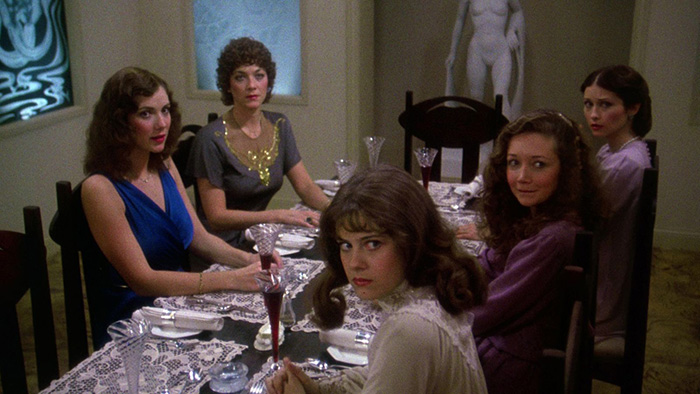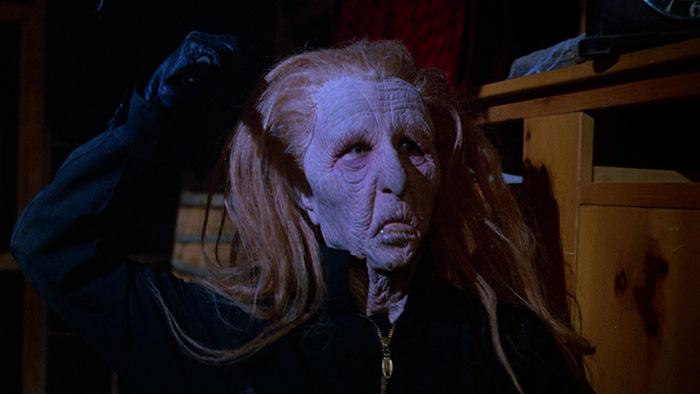Call it research.
By the end of Peter R. Simpson‘s Curtains—I use the producer’s name since he ultimately finished the film two years after original director Richard Ciupka left with only forty-five minutes shot—there are just three surviving characters. One is the potential victim being chased, another the homicidal maniac under a plastic old woman mask who’s killed the rest, and the last of the trio off-screen somewhere so we’re left to question the murderer’s identity. Will it be revealed that it’s been the person we’ve thought it was since this whole charade began? Or will screenwriter Robert Guza Jr. find some convoluted way to make it someone without any clear-cut motivation? And more importantly: will we still care by that point? I know I sure didn’t.
My reaction after reading about the myriad behind the scenes issues on the film was to simply nod my head in acknowledgement because the final result feels incomplete, tonally off-the-wall, and incoherent. I’m not even certain why it’s become such a cult classic besides a desire to make a drinking game out of how many times the boom mic infiltrates the frame. Every death’s gore occurs off-screen—we see the fearful eyes as throats are slit. The acting isn’t bad enough to warrant laughter despite the characters themselves deserving it. The nudity is gratuitous to the point of arriving without rhyme, reason, or necessity. And the underlying theme that actresses are so “hysterical” that they’d literally do anything to get a role moves beyond plain misogyny.
The plot surrounds director Jonathan Stryker (John Vernon) and his unorthodox decision to invite six women to his secluded mansion as a screen test for the movie Audra that he’s spent years developing with muse Samantha Sherwood (Samantha Egger). Why wasn’t she given the title role sight unseen? Well, she asks that question too since she willfully committed herself into an insane asylum with Stryker’s help to research the character’s insanity. But as she absorbed the plight of those who actually belonged in that hospital, he started to believe she was losing the fire she once possessed. So he left her there to pursue younger actresses for his film and his bed. Unbeknownst to him, however, was that Samantha escaped upon hearing about the casting call in Variety.

This set-up between Stryker and Samantha is lengthy—I’d say almost a quarter of the film’s duration. We spend all this time with the two of them through their adversarial relationship on the stage and their gradual fractioning on opposing sides of a mental institution’s table only to shift our attention onto strangers with little to no exposition. We learn that Patti O’Connor (Lynne Griffin) is a comedian with always fresh material for open mic night (she jokes about Stryker’s proposition) and that Brooke Parsons (Linda Thorson) is a dedicated performer whose star has fallen to the point of needing her agent to book weird auditions. We don’t even meet Christie Burns (Lesleh Donaldson), Laurian Summers (Anne Ditchburn), or Tara DeMillo (Sandee Currie) until we’re at the mansion.
That’s five of the six potential stars with Amanda Teuther (Deborah Burgess) rounding out the group. She doesn’t make it to Stryker’s, though, as she’s murdered the previous day. It’s an odd scene with deflection upon deflection courtesy of a role-playing boyfriend and horrible nightmare. Despite these false starts, Amanda is eventually dispatched of by the aforementioned killer in a “granny” mask—with help from a creepy, frowning doll that’s way too iconic (and on the poster) to be used for only one more scene. Because Amanda can’t attend Stryker’s event, Samantha’s party-crasher straight from the asylum is able to slide into the competition. The five remaining women must now impress their maestro while the legend they’re replacing watches with rage. And one by one they all fall.
Curtains is actually a timely film today what with the Harvey Weinstein scandal amongst others. It’s script hinges upon “casting couch” culture with one character saying she’d have sex with Stryker, another saying she’d give him oral, and at least two others actually finding themselves in bed with the lecherous monster. We watch as he comforts them at night despite terrorizing them during the day with verbal and psychological abuse to get what he wants. Stryker is such an “auteur” that he was willing to leave the woman who was apparently by his side through all his success for dead because she became too “difficult” to handle. The filmmakers having the killer—whomever it is—kill out of jealousy only exacerbates the damaging image of feminine “temperament.”

The least Guza, Ciupka, and Simpson could do was make the journey dramatically entertaining despite their misguided propulsion, but they can’t even do that right. (Perhaps I shouldn’t lump Ciupka in with that group considering he took his name off the production due to creative differences.) Instead we receive a disjointed series of murders without escalating stakes or a purposeful sequential order. Someone dies in a way that makes us assume the murderer’s identity. Another bites it on an ice pond with the inspired imagery of the “granny” killer skating with sickle in-hand. The mask becomes duplicated (or misplaced at times that make no sense) to sow confusion. And one character (Michael Wincott) disappears while the killer watches so we don’t know if he’s alive, dead, or important.
“Granny” mask moves as though through teleportation despite being knocked unconscious more than once, the climactic chase scene inside a prop garage with only three characters left is over-long (much like an early “rape” scene and pretty much any attempt at suspense), and every woman is ostensibly drawn to be the “ideal” subservient plaything that’s willing to do the bidding of their domineering “artist”. But this last point isn’t ironic or satirical—it’s presented as though this is simply how the industry works. So despite being a Canadian production, Simpson’s film epitomizes the “Hollywood culture” so many of today’s accused sex offenders seek to use as an excuse. Making one an empowered killer doesn’t fit any feminist agenda, though. It does the opposite by feeding female instability stereotype.

Watched in conjunction with Season Three of Buffalo, NY-based horror series Thursday Night Terrors, curated by Peter Vullo. Logo/illustration by Josh Flanigan.

